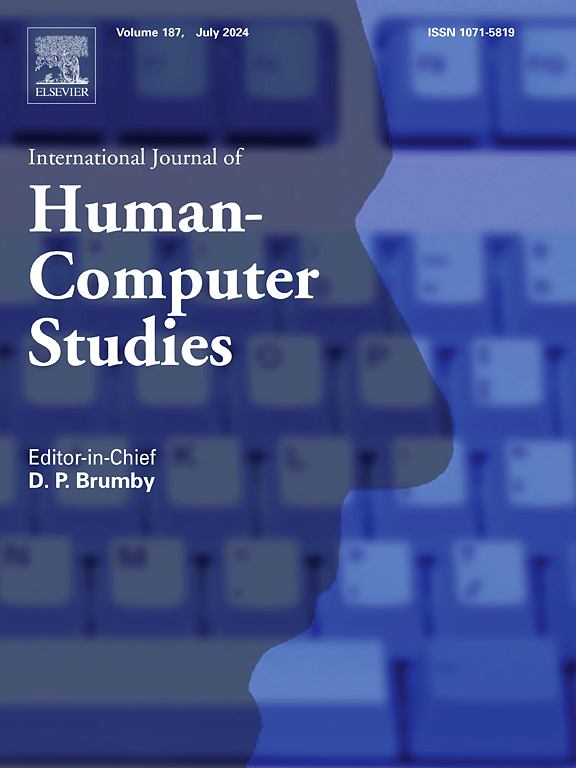微手势 + 把握:从人类能力到微手势互动之旅
IF 5.3
2区 计算机科学
Q1 COMPUTER SCIENCE, CYBERNETICS
International Journal of Human-Computer Studies
Pub Date : 2024-11-22
DOI:10.1016/j.ijhcs.2024.103398
引用次数: 0
摘要
微手势,即快速而微妙的手指动作,在泛在交互中显示出巨大的潜力。然而,迄今为止的研究要么侧重于抓握情境(握住物体),要么侧重于空手情境(不握住物体)。这两种情境会影响微手势的可行性。研究人员已经创建了一套适用于整个日常抓握分类的微手势,称为可转移微手势。然而,与自由手势相比,这些集合包含的微手势数量有限,因为自由手势的微手势是根据手指触摸的部位或使用的手指数量等精细特征区分的。我们提供了识别和辨认微手势的知识和方法,这些微手势可以在不同语境中转换。首先,我们报告了一项关于人体工程学因素的研究,这些因素会影响微手势在特定语境中的可行性。然后,我们提出了一个概念模型,作为确定微手势在特定情境中可行性的工具,而无需进行耗时的用户研究。不出所料,并非所有的微手势都能适用于所有的语境。因此,我们揭示了两种定义微手势的不同方法,即一组微手势可在自由手势和抓握手势之间转换。最后,我们报告了一项关于可转换微手势集识别因素的用户研究。本文章由计算机程序翻译,如有差异,请以英文原文为准。
Microgesture + Grasp: A journey from human capabilities to interaction with microgestures
Microgestures, i.e. fast and subtle finger movements, have shown a high potential for ubiquitous interaction. However, work to-date either focuses on grasp contexts (holding an object) or on the free-hand context (no held object). These two contexts influence the microgestures feasibility. Researchers have created sets of microgesture feasible across the entire taxonomy of everyday grasps, called transferable microgestures. However, those sets include a limited number of microgestures as compared to those for the free-hand context, for which microgestures are distinguished according to fine characteristics such as the part of the finger being touched or the number of fingers used. We provide knowledge and methods for identifying and recognizing microgestures that can transfer across contexts. First, we report a study on ergonomics factors that influence the feasibility of a microgesture in a given context. Then, we propose a conceptual model serving as a tool to determine the feasibility of a microgesture in a given context without the need for time-consuming user studies. As expected, not all microgestures were transferable to all considered contexts. Thus, we then expose two different ways of defining a set of microgestures transferable between free-hand and grasping contexts. Finally, we report a user study on recognition factors of a transferable microgesture set.
求助全文
通过发布文献求助,成功后即可免费获取论文全文。
去求助
来源期刊

International Journal of Human-Computer Studies
工程技术-计算机:控制论
CiteScore
11.50
自引率
5.60%
发文量
108
审稿时长
3 months
期刊介绍:
The International Journal of Human-Computer Studies publishes original research over the whole spectrum of work relevant to the theory and practice of innovative interactive systems. The journal is inherently interdisciplinary, covering research in computing, artificial intelligence, psychology, linguistics, communication, design, engineering, and social organization, which is relevant to the design, analysis, evaluation and application of innovative interactive systems. Papers at the boundaries of these disciplines are especially welcome, as it is our view that interdisciplinary approaches are needed for producing theoretical insights in this complex area and for effective deployment of innovative technologies in concrete user communities.
Research areas relevant to the journal include, but are not limited to:
• Innovative interaction techniques
• Multimodal interaction
• Speech interaction
• Graphic interaction
• Natural language interaction
• Interaction in mobile and embedded systems
• Interface design and evaluation methodologies
• Design and evaluation of innovative interactive systems
• User interface prototyping and management systems
• Ubiquitous computing
• Wearable computers
• Pervasive computing
• Affective computing
• Empirical studies of user behaviour
• Empirical studies of programming and software engineering
• Computer supported cooperative work
• Computer mediated communication
• Virtual reality
• Mixed and augmented Reality
• Intelligent user interfaces
• Presence
...
 求助内容:
求助内容: 应助结果提醒方式:
应助结果提醒方式:


